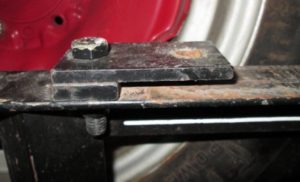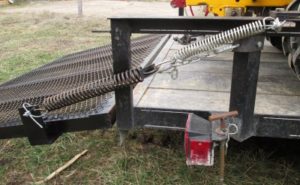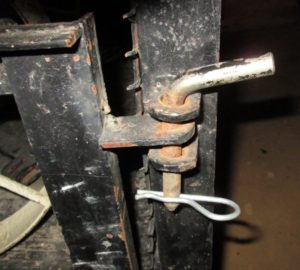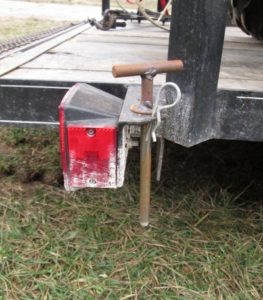If you’re going to collect and show garden tractors, it doesn’t take long to realize you need a trailer to transport them to shows. And, as a side note, no matter what size you purchase, it will be too small—just like the building you build for storing them. When we became serious about collecting and displaying Cub Cadets, my wife and I purchased a 6 ½ by 14 foot trailer with a 4 foot ramp/tailgate. (Of course the trailer is too small!!) To make the most efficient use of the limited space, I marked off a 6 ½ by 14 foot area on a concrete pad and experimented with different configurations to determine the most efficient loading arrangement for our various tractors and attachments.
Because not every tractor runs all the time and some attachments are very heavy, the first order of business for any trailer should be a winch. Even a small winch is better than no winch.
Besides the addition of a winch to our trailer, one other problem soon became obvious. It was going to require some sort of method to secure the tractors in these various arrangements. Although the trailer has a 12 inch high railing around three sides, it was going to be necessary to provide additional attachment locations for the ratchet straps. A little research showed that a lot of collectors used rope rings bolted to the trailer floor at various locations to accomplish this task. I didn’t particularly like this idea since the same tractor with the same attachment would always have to be in the same location and properly aligned with the ring. I wanted more flexibility.
The method I settled on involved installing brackets along the side rails which allowed me to place an angle iron across the trailer from side to side. The bracket just consisted of a flat piece of metal bolted to the trailer side with enough clearance to slide the angle under and drop a pin through to secure the angle in place.
With a little experimentation and measurement, I located several of these brackets along each side of the trailer. Depending on the size of the tractor and attachment, I pick the proper location for the angle iron that can be used to secure the tractor in position and drop a pin through to hold it in position.
If I determine a better configuration or obtain another tractor that doesn’t fit the current arrangement, I can just add another bracket to the tractor rails and I’m back in business – ready to load up and head to another show.
There was one major drawback to my solution for securing tractors. As I’ve gotten older, that 4 foot tailgate has gotten heavier. At least it seems that way. The brackets I’ve added to the side rails are in the way of installing most commercial tailgate lift assist systems. I toyed with the idea of adding some sort of spring system that extended under the trailer, but the cabling became pretty complicated. When I saw the “Gate-R Lift” setup, I knew I had to try that method instead. That system uses a short spring mounted under the side rails that connects to an angle bracket connected to the rear gate. It is a very compact system.
It took a year of searching at flea markets, but I finally found a spring that I thought would work. I had to weld an additional section of 2 inch angle to the rear gate where the angle bracket would connect to make a box section to prevent twisting and add strength.. I bent the “L” bracket for the rear spring connection and bolted it in position. (I only weld when there is no other choice.) I originally used a C-clamp to hold the bracket in position to experiment with different locations for the best result.
The location of the “L” bracket required that I make a longer pin to hold the tailgate in the raised position.
I used a length of chain with the spring and experimented with different chain lengths to get what I thought was the optimal lift assistance.
I was pleased with the results over the limited range of the spring. From the lowered position to about 30 degrees above horizontal, the system worked great. But from 30 degrees to vertical, the spring provided no help. (But, it made a huge difference to that point.) Since I’d searched so long to find this spring, I knew there was no use searching for another, longer, better suited spring. Instead, I added a smaller, weaker spring to add lifting assistance for that last section. Again, with some experimentation, I determined where to anchor the additional spring.
The chain limits how much this smaller spring can be stretched. It adds a little assistance when the gate is lowered all the way, but mainly helps after the larger spring is no longer effective.
I added a cable that runs through both springs and secured it at both ends for safety in case either spring breaks or comes unhooked while in the extended position.
I have made one other simple, probably obvious, modification to the trailer. It was always a problem finding a place to store the pins that hold up the tailgate when it was in a lowered position. We were continually losing track of them.
We struggled with that for several years, until I came up with an obvious solution. I drilled two holes in the angle that supports the trailers rear lights. Both pins can now be safely stored there while we’re loading and unloading tractors and attachments.
That’s it until I think of something else or see something clever that someone else has done.
So, in the meantime, Happy “trailering”.















